Epson ActionNote 650, ActionNote 650C, ActionNote 660C User Manual

User’s Guide
Printed on recycled paper with at least 10% post-consumer content

IMPORTANT NOTICE
DISCLAIMER OF WARRANTY
Epson America makes no representations or warranties, either express or implied, by or with respect to anything in this manual, and shall not be liable for any implied warranties of merchantability and fitness for a particular purpose or for any indirect, special, or consequential damages. Some states do not allow the exclusion of incidental or consequential damages, so this exclusion may not apply to you.
COPYRIGHT NOTICE
All rights reserved. No part of this publication may be reproduced, stored in a retrieval system, or transmitted, in any form or by any means, electronic, mechanical, photocopying, recording, or otherwise, without the prior written permission of Epson America, Inc. No patent liability is assumed with respect to the use of information contained herein. Nor is any liability assumed for damages resulting from the use of the information contained herein. Further, this publication and features described herein are subject to change without notice.
TRADEMARKS
EPSON is a registered trademark of Seiko Epson Corporation
Action Note is a trademark, and EPSON Connection and EPSON Direct are service marks of Epson America, Inc.
General notice: Other product names used herein are for identification purposes only and may be trademarks of their respective owners. EPSON disclaims any and all rights in those marks.
The Energy Star emblem does not represent EPA endorsement of any product or service.
Copyright © 1995 by |
Epson America, Inc. |
400387400-2 |
Torrance, California, |
USA |
3/95 |
i i
Important Safety Instructions
Read all of these instructions and save them for later reference. Follow all warnings and instructions marked on the computer.
● Turn off the computer before cleaning. Clean with a damp cloth only. Do not spill liquid on the computer.
● Use only the type of power source indicated on the computer’s label.
●Connect all equipment to properly grounded power outlets. Avoid using outlets on the same circuit as photocopiers or air control
systems that regularly switch on and off.
● Do not let the computer’s power cord become damaged or frayed.
● If you use an extension cord with the computer, make sure the total ampere rating of the devices plugged into the extension cord does not exceed the cord’s ampere rating. Also, make sure the total of all devices plugged into the wall outlet does not exceed 15 amperes.
● Except as specifically explained in this User's Guide, do not attempt to service the computer yourself.
● Unplug the computer and refer servicing to qualified service personnel under the following conditions:
If the power cord or plug is damaged; if liquid has entered the
computer; if the computer has |
been dropped or the cabinet |
damaged; |
|
if the computer does not operate normally or exhibits a distinct |
|||
change |
in performance. Adjust |
only those controls that are |
covered |
by the |
operating instructions. |
|
|
●When traveling by airplane, be sure to take your computer into the passenger compartment as carry-on luggage to prevent it from being stored in an unpressurized storage area.
●If you plan to use the computer in Germany, observe the following:
To provide adequate short-circuit protection and over-current protection for this computer, the building installation must be protected by a 16 Amp circuit breaker.
Beim Anschluß des Computers an die Netzversorgung muß sichergestellt werden, daß die Gebäudeinstallation mit einem 16 A Überstromschutzschalter abgesichert ist.
iii

Importances Instructions de Sécurité
Lire attentivement les instructions suivantes et les conserver pour les consulter en cas de besoin. Observer soigneusement tous les avertissements et directives marques surl’ordinateur.
● Débrancher l’ordinateur avant de le nettoyer. N'utiliser qu‘un |
chiffon |
||||
humide. Veiller à |
ne pas renverser de liquides sur |
l’appareil. |
|
||
● Utiliser seulement |
le type de |
source d‘alimentation |
électrique |
indiqué |
|
sur |
l’étiquette. |
|
|
|
|
● Tout |
l’équipement |
doit être branché sur des prises |
de courant |
propre. |
|
Ne jamais utiliser une prise sur le même circuit qu’un appareil à |
|||||
photocopies ou un système de contrô1e de ventilation avec |
|
||||
commutation marche-arrêt |
automatique. |
|
|
||
●S’assurer que le cordon d’alimentation de l’ordinateur n’est pas abîmé ni effiloché.
●Dans le cas où on utilise un cordon de rallonge avec l’ordinateur,
s’assurer que l’intensité en ampères requise pour tous les appareils branchés sur ce cordon ne soit pas supérieure à la capacité du cordon. S’assurer aussi que cette intensité ne dépasse jamais la somme de 15 ampères pour l’ensemble des appareils.
● Sauf |
dans les cas spécifiques |
expliqués dans ce manuel de l’usager, |
ne |
pas essayer d’entretenir |
ou de réparer l’ordinateur soi-même. |
● Débrancher l’ordinateur et contacter un technician qualifié dans les circonstances suivantes:
Si le cordon ou la prise sent abîmés; si un liquide a pénétré à
l’intérieur de l’appareil; si on |
a laissé tomber l’appareil ou si le boîtier |
||
est endommagé; si l’ordinateur ne fonctionne pas normalement ou |
|||
fonctionne d‘une manière très |
difference de l’ordinaire. N‘ajuster que |
||
les |
commandes |
décrites dans |
les directives. |
● Pour |
les voyages |
par avion, prendre l’ordinateur avec soi dans la |
|
cabine comme bagage à main, pour éviter qu’il soit transporté dans |
|||
une |
soute non |
pressurisée. |
|
● Pour utiliser l’ordinateur en Allemagne, il est nécessaire que le bâtiment soit muni d’un disjoncteur de 16 amperes pour protéger l’ordinateur contre les courts-circuits et le survoltage.
iv
FCC COMPLIANCE STATEMENT
FOR AMERICAN USERS
This equipment has been tested and found to comply with the limits for a class B digital device, pursuant to Part 15 of the FCC Rules. These limits are designed to provide reasonable protection against harmful interference in a residential installation. This equipment generates, uses, and can radiate radio frequency energy and, if not installed and used in accordance with the instructions, may cause harmful interference to radio and television reception. However, there is no guarantee that interference will not occur in a particular installation. If this equipment does cause interference to radio and television reception, which can be determined by turning the equipment off and on, the user is encouraged to try to correct the interference by one or more of the following measures:
Reorient or relocate the receiving antenna
Increase the separation between the equipment and receiver
Connect the equipment into an outlet on a circuit different from that to which the receiver is connected
Consult an experienced radio/ TV technician for help.
WARNING
The connection of a non-shielded equipment interface cable to this equipment will invalidate the FCC Certification of this device and may cause interference levels that exceed the limits established by the FCC for this equipment. It is the responsibility of the user to obtain and use a shielded equipment interface cable with this device. If this equipment has more than one interface connector, do not leave cables connected to unused interfaces.
Changes or modifications not expressly approved by the manufacturer could void the user’s authority to operate the equipment.
FOR CANADIAN USERS
This digital apparatus does not exceed the Class Blimits for radio noise emissions from digital apparatus as set out in the radio interference regulations of the Canadian Department of Communications.
Le présent appareil numérique n’émet pas de bruits radioé1ectriques dépassant les limites applicable aux appareils numériques de Classe B prescrites dans le règlement sur le brouillage radioélectrique édicté par le Ministère des Communications du Canada.

Contents
Introduction
Computer |
Features .. . . . . |
. . . . . . . . |
1 |
||||||
Power-saving Features . . . . . . . . . . . . . . . . . . . . . . ...3 |
|||||||||
What This Manual Covers . . . . . . . . . . . . . . . . . . . . ...3 |
|||||||||
Conventions |
Used |
in |
This |
Manual. |
. . . . . . . . . |
4 |
|||
Where |
to |
Get Help . . . . . . . . . . . . . . |
. . .. . . |
5 |
|||||
CompuServe On-line Support. . .. . . . . . . . . 6 |
|||||||||
Chapter 1 |
Setting Up the Computer |
|
|
||||||
|
|||||||||
Opening the Screen . . . . . . . . . . . . . . . . . . . . . . . . ...1-1 |
|||||||||
Identifying |
the System |
Components. . . . . . . . . . . . . . |
1-2 |
||||||
Connecting |
the |
AC |
Adapter. . . . . . . . . . . |
1-3 |
|||||
Turning |
the Computer |
On |
and Off. . . . . . . . . . . . . . |
1-5 |
|||||
Reading the System Window Icons. . . . . . . . . . . 1-7 |
|||||||||
Making Backup Copies of Your Files. . . . . . . . . . . . . 1-8 |
|||||||||
Running |
the System Configuration |
Utility. . . . . . . . . . . . . |
1-8 |
||||||
When to Run the System Configuration Utility. . . . . . . . . 1-9 Starting the Utility . . . . . . . . . . . . . . . . . . . . . . ...1-9
Changing |
the Settings . . . . . . . . . . . . . . |
. . . . . . ...1-10 |
|
S e t t i n g , D e l e t i n g , a n d C h a n g i n g a P a s s w o r d 1 - 1 3 |
|||
Setting a password . . . . . . . . . . . . . . .. . . . . . . . . . . . |
1-14 |
||
Deleting or changing a password. . . . . . . . . . . |
. . . . . . . . . 1-14 |
||
Setting the Power Management Options . . . . . |
. . . . . . |
1-15 |
|
Exiting the System Configuration Utility . . . . . . |
. . . . . . . |
1-18 |
|
Chapter 2 |
Using Your Computer |
|
|
|
|
|
|
Caring for the Computer . . . . . . . . . . . . . . . . . . . . . ...2-1
|
Protecting |
the Hard |
Disk. . . . . . . . . . |
.. . |
. . . 2-2 |
||
Using |
Energy Wisely . . . . . . . . . . . . . . . . . . . . . . . |
...2-3 |
|||||
Using |
the Keyboard . . . . . . . . . . . . . . . . . . . . . . . . |
...2-3 |
|||||
|
Using |
the Fn Key . . . . . . . . . . . . . . . . . . . . . . . ...2-4 |
|||||
|
Using |
the |
Embedded |
Keypad. . . . . . . . . . . |
|
. 2-5 |
|
v

Using the Trackball . . . . . . . . . . . . . . . . . . . . . . . . ...2-6 Cleaning the Trackball . . . . . . . . . . . . . . . . . . . ...2-8 Resetting the Computer . . . . . . . . ... . 2-9 Changing the CPU Speed. . . . . . . . . . . . . . . . 2-9
Using Password Security . . . . . . . . . . . . . . . . . . . . . ...2-10 Entering a Boot Password. . . . . . . . . . . . 2-11 Entering an SCU Password. . . . . . . . . . . . . 2-11 Using Diskettes . . . . . . . . . . . . . . . . . . . . . . . . . . ...2-12 Using Video Drivers and Utilities . . . . . . . . . . . . . . . . 2-13 Configuring PC Cards . . . . . . . . . . . . . . . . . . . . . . ...2-14 Installing Additional PC Card Drivers and Utilities . . . . . . . . . . . . . 2-15
Chapter 3 Powering the Computer
Using the AC Adapter . . . . . . . . . . . . . . . . . . . . . . ...3-1 Using the Battery . . . . . . . .. . . . . . . . . 3-2 Monitoring Battery Power. . . . . . . . . . . 3-4 Replacing the Battery . . . . . . . . . . . . . . . . . . . . ...3-7 Recharging the Battery . . . . . . . . . . . . . . . . . . . ...3-8
Using the Power Management Features. . . . .. . . . . . . . . . 3-10 Automatic Features . . . . . . . . . . . . . . . . . . . . . ...3-12 Manual Features . . . . . . . . . . . . . . . . . . . . . . . ...3-13 Resuming Activity From Suspend Mode . . . . . . . . . . . . . . 3-14 Using the APM Interface . . . . . . . . . . . . . . . 3-15 Using Suspend to Disk Mode. . . . . . . . . . . . .. 3-16
Creating the Suspend to Disk data file. . . . . . . . . . . 3-17 Recreating the Suspend to Disk data file. . . . . . . . .. 3-19
Chapter 4 Installing Optional Devices
Connecting an External Monitor . . . . . . . . . . . . . . . . . 4-1 Connecting a Parallel Device. . . . . . . . . . . . . . . . . . 4-3 Connecting a Serial Device . . . .. . . . . . . . . . . . . . . 4-4 Checking the Serial Port Settings. . . . . . . . . . . . . . . . 4-5 Connecting an External Keyboard or Mouse. . . . . . . . . . . . . . 4-5 Installing a PC Card .. . . . . . . . . . . . . . . . . . . . ...4-7 Installing a Memory Module. . .. . . . . . . . . . . . . . . . . . . . . 4-8
Removing and Replacing the Hard Disk Drive . . . . . . . . . . . . . . . . . 4-13
vi
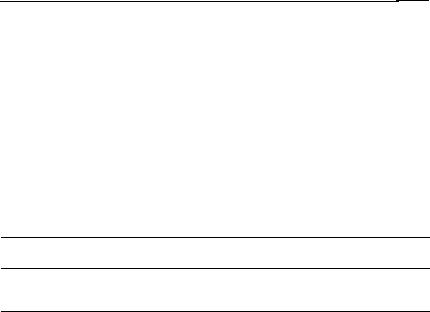
Chapter 5 |
Troubleshooting |
|
Identifying Your System . . . . . . . . . . . . . . . . . . . . . . . . |
5-1 |
|
Error Messages . . . . . . . . . . . . . . . . . . . . . . . . . . . . . . |
5-3 |
|
The Computer Won’t Start . . . . . . . . . . . . . . . . . . . . . . . |
5-3 |
|
Battery Problems . . . . . . . . . . . . . . . . . . . . . . . . . . . . . |
5-4 |
|
AC Adapter Problems . . . . . . . . . . . . . . . . . . . . . . |
5-5 |
|
The LCD Screen Is Blank . . . . . . . . . . . . . . . . . . . . . . . . |
5-6 |
|
The External Monitor Screen Is Blank. . . . . . . . . . . . . . . . . . . . . . . . . |
5-7 |
|
The Computer Locks Up...... . . . . . . . . . . . . . . . . . . |
5-8 |
|
Password Problems . . . . . . . . . . . . . . . . . . . . . . . . . . . |
5-9 |
|
Embedded Keypad Problems . . . . . . . . . . . . . . . . . . . . . |
5-9 |
|
Trackball Problems . . . . . . . . . . . . . . . . . . . . . . . . . . . |
5-9 |
|
External Pointing Device Problems . . . . . . . . . . . . |
5-10 |
|
Diskette Problems . . . . . . . . . . . . . . . . . . . . . . . . . . . . |
5-11 |
|
Diskette Drive Problems . . . . . . . . . . . . . . . . . . . . . . . . |
5-12 |
|
Hard Disk Problems . . . . . . . . . . . . . . . . . . . . . . . . . . . |
5-12 |
|
Software Problems . . . . . . . . . . . . . . . . . . . . . . . . . . . . |
5-13 |
|
Printer Problems . . . . . . . . . . . . . . . . . . . . . . . . . . . . . |
5-14 |
|
Memory Module Problems . . . . . . . . . . . . . . . . . . . . . . . |
5-14 |
|
PC Card Problems . . . . . . . . . . . . . . . . . . . . . . . . . . . . |
5-15 |
|
Appendix A Specifications
CPU and Memory . . . . . . . . . . . . . . . . . . . . . . . . . . .. A-l Controllers . . . . . . . . . . . . . . . . . . . . . . . . . . . . . . .. A-2 Interfaces . . . . . . . . . . . . . . . . . . . . . . . . . . . . . . . .. A-3 Keyboard . . . . . . . . . . . . . . . . . . . . . . . . . . . . . . . .. A-3 Trackball . . . . . . . . . . . . . . . . . . . . . . . . . . . . . . . . .. A-3 Mass Storage . . . . . . . . . . . . . . . . . . . . . . . . . . . . . .. A-3 LCD Screen . . . . . . . . . . . . . . . . . . . . . . . . . . . . . . .. A-4 System Configuration Utility. . . . . . . . . . . . . . A-4 Power sources . . . . . . . . . . . . . . . . . . . . . . . . . . . . .. A-4 Environmental Requirements. . . . . . . . . . . . . . . A-5 Physical Dimensions . . . . . . . . . . . . . . . . . . . . . . . . .. A-5 Optional Equipment . . . . . . . . . . . . . . . . . . . . . . . . . .. A-6
Index
vii
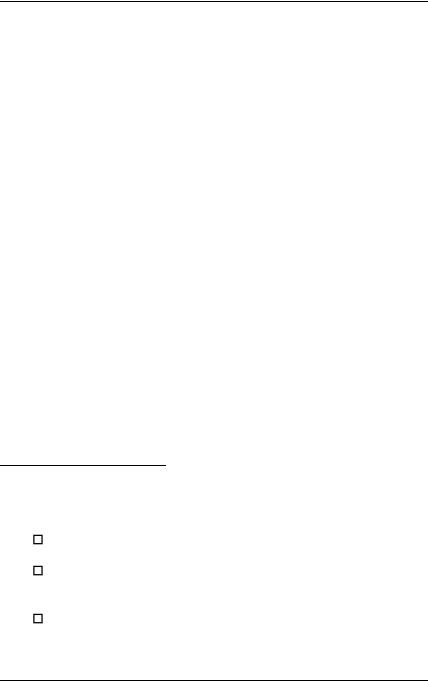
Introduction
The EPSON® ActionNote TM 600 Series notebook computers give you exceptional speed, display quality, and expaddability—all packaged in the latest in notebook computer technology.
The ActionNote computer has 4MB of standard memory on the system board. Some systems have an additional 4MB memory module installed (check your system startup screen). Your ActionNote also comes with pre-installed MS-DOS,®
Microsoft ® W i n d o w s ,T M and other |
software |
so you can |
run a |
vast array of the latest programs, |
utilities, |
and games |
designed |
for productivity and fun. |
|
|
|
Your high-capacity hard disk drive will hold the hundreds of program and data files you create as you use your computer.
And when you‘re ready to acquire more capability, your computer’s two PCMCIA card slots allow you to quickly and easily add flash RAM, fax/ modem, local area network (LAN), and other PC card options.
You can even use your ActionNote like a desktop PC when you‘re not on the road; just connect an external monitor, keyboard, mouse, and printer.
Computer Features
Your computer comes with the following features:
486DX2 microprocessor with 8KB of internal cache
4MB of RAM on the system board (additional 4MB memory module installed on some systems), expandable to 20MB
512KB of video RAM
Introduction 1

LCD screen supporting VGA resolutions of 640 x 480 in 256 colors or 64 gray shades
High-speed, 32-bit local bus video technology supports resolutions up to 1024 x 768 in 16 colors or 800 x 600 in 256 colors on an external monitor
High-capacity hard disk drive
Built-in 16 mm trackball with two buttons
Two stacked PCMCIA |
Type II slots, |
supporting two Type I |
or Type II cards or one |
Type III card |
|
Long-lasting, rechargeable NiMH battery
Compact AC adapter
Pre-installed software on your hard disk drive, including MS-DOS, Microsoft Windows, and in any other programs
On-line computer user’s guide, Windows manual, and other manuals providing instructions and inform ation while you are on the road.
Your ActionNote has been configured for you and the hard disk drive already contains most of the software you need. Video drivers have already been installed and you can select whether to load your PCMCIA drivers and utilities each time you boot your computer.
See the card titled “For Software Support” that came with your computer for a list of the manuals, diskettes, and brochures that are included with your software.
Also see the “About EPSON” group window in Windows for the latest information about your ActionNote and about EPSON’s services.
2 Introduction

Power-saving Features
The ActionNote complies with the United States Environmental Protection Agency’s Energy Star Program, which prom otes the manufacture of energy-efficient printers, computers, and monitors. Your computer’s power management features place the system in low-power standby and suspend modes when it has been inactive for specified periods of time. The System Configuration utility lets you customize the way your computer saves power so you can ensure that the power management features fit the way you work.
Note
If you use an Energy Star compliant external monitor with your computer, it also enters a low-power standby mode because it is not receiving video signals from your computer. (Screens on non-compliant monitors become blank but do not enter a low-power mode.)
What This Manual Covers
You do not need to read everything in this book to use your computer; see the following chapter summaries:
Chapter 1 provides steps for setting up your computer.
Chapter 2 covers basic information about using the computer.
Chapter 3 explains how to power your computer with the
AC adapter or the battery and how to conserve battery power.
Chapter 4 describes how to connect optional devices, install additional memory, and remove the hard disk drive.
Introduction 3

Chapter 5 provides troubleshooting tips.
Appendix A lists the computer’s specifications.
At the end of them anual, you’ll find an Index and a list of EPSON U.S. and international marketing locations.
Conventions Used in This Manual
This manual uses the following type conventions in the text:
Example |
Meaning |
|
|
Enter |
Keys you press on the keyboard |
|
|
Fn F12 |
Keys you press at the same time; hold down the |
|
key marked Fn and press the F12 key |
|
|
C: \DOS |
Text as it appears on the screen |
|
|
DISKCOPY A: B: |
Text that you type exactly as shown |
|
|
4 Introduction

Where to Get Help
If you purchased your computer in the United States or Canada, EPSON provides customer support and service through a network of Authorized EPSON Customer Care Centers. EPSON also provides support services through the EPSON Connection.SM In the United States or Canada, dial (800) 922-8911.
Call the EPSON Connection for the following:
Technical assistance with |
the installation, configuration, |
and operation of EPSON |
products |
Assistance in locating your nearest Authorized EPSON
Reseller or Customer Care Center
Assistance with Extra Care Road Service
Customer relations
EPSON technical information library fax service
Product literature on current and new products.
You can purchase accessories, manuals, or parts for EPSON products from EPSON Accessories at (800) 873-7766 (U.S. sales only). In Canada, call (800) 922-8911.
When you call for technical assistance, be ready to identify your system and its configuration, and provide any error messages to the support staff. See Chapter 5 for more information.
If you purchased your computer in the United States or Canada, EPSON also provides Extra Care Road Service. Your ActionNote package should contain information on this program; if not, call the EPSON Connection.
Introduction .5
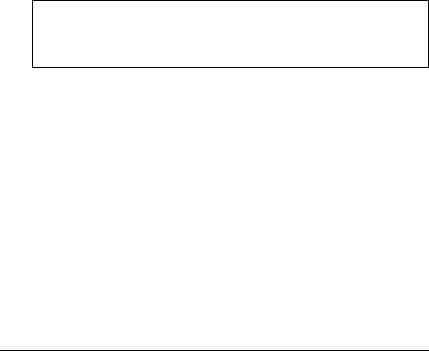
If you purchased your computer outside the United States or Canada, contact your EPSON dealer or the marketing location nearest you for customer support and service. International marketing locations are listed at the end of this manual.
If you need help with any software application program you
are |
using, see the documentation that came with that program |
for |
technical support information. |
CompuServe On-line Support
Your computer includes the CompuServe® W i n C I M information manager and a free CompuServe membership. This membership entitles you to an introductory $15 usage credit on CompuServe’s extended services and forums. The brochure that came with your computer describes the CompuServe services and how to access them, as well as providing subscription information.
Note
To access CompuServe, you must install a modem PC card in your computer.
The fastest way to access helpful tips, specifications, drivers, application notes, tables for DIP switch or jumper settings, and bulletins for EPSON products is through the Epson America Forum on CompuServe.
To access the Epson America Forum, simply click on the green traffic light icon and type EPSON at the menu prompt.
6 Introduction
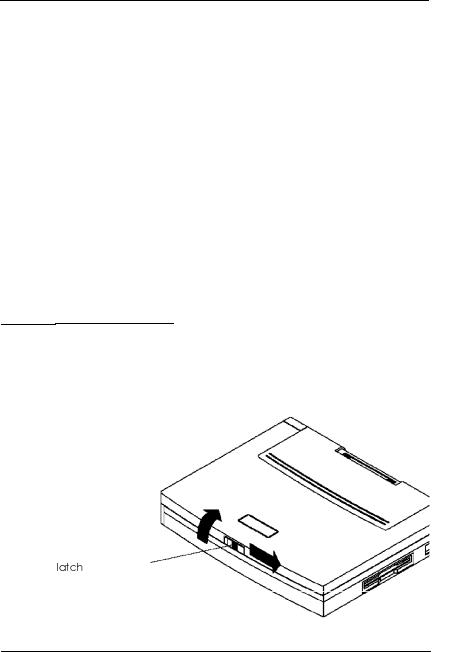
Chapter 1
Setting Up the Computer
This chapter describes how to setup your computer. It covers:
Opening the screen
Identifying the system components
Connecting the AC adapter
Turning the computer on and off
Reading the System Window icons
Backing up files
Running the System Configuration utility (SCU).
Opening the Screen
To |
open |
the |
LCD |
screen, |
slide the latch on the computer’s lid to |
the |
right |
and |
lift |
the lid |
upward. |
Setting Up the Computer 1-1
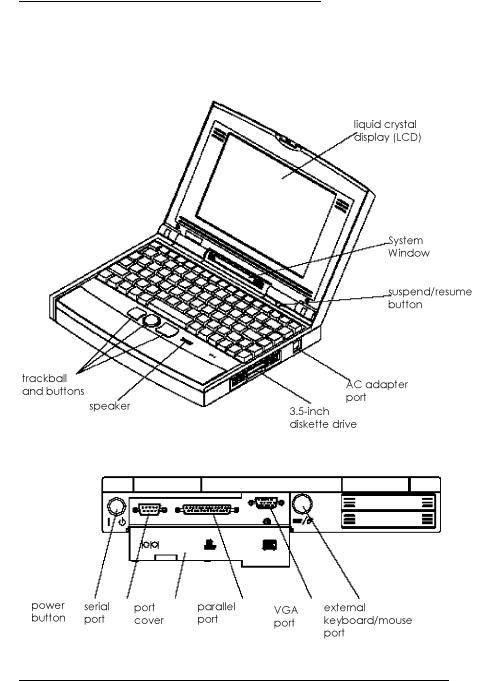
ldentifying the System Components
Use the illustrations below to help you identify your system components.
1-2 Setting Up the Computer
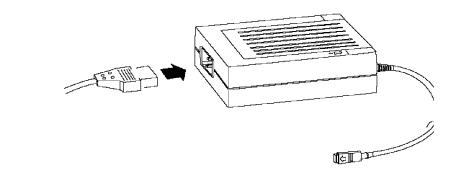
Connecting the AC Adapter
The AC adapter included with your computer can be used in most countries because it operates in the input ranges
100-250 VAC with frequencies of 47-63 Hz. If you are using the adapter in a country other than the one where you purchased your computer, make sure you have the correct power cord before you connect the AC adapter to an electrical outlet.
Caution
Use only the adapter designed for the ActionNote 600 Series computer (model number TSA3), or you could damage the computer.
To connect the AC adapter, first connect the adapter’s power cord to the connector, as shown below.
Setting Up the Computer 1-3

Position |
the |
connector |
on |
the AC adapter cable so the |
side with |
the arrow faces up. Then |
connect the cable to the AC |
adapter |
|||
port on |
the |
right side |
of |
the computer. |
|
Plug the adapter’s power cord into an electrical outlet. The green power light on the adapter comes on and the AC Power icon (the plug) appears in the computer’s System Window. (See
page |
1-7 for a description of the System Window icons.) |
For |
more information about powering the computer with the |
AC adapter, see Chapter 3. For instructions on connecting optional equipment to your computer, see Chapter 4.
1-4 Setting Up the Computer

Turning the Computer On and Off
The first time you use your computer, the battery may not be charged (NiMH batteries lose up to 20% of their charge each week they aren’t recharged), so make sure the AC adapter is connected. Then press the power button on the back panel to turn on the computer.
The computer beeps and then begins a series of power-on diagnostics that check the circuit boards, memory, ports, keyboard, and disk drives.
First you see this prompt:
Press SPACEBAR to skip memory test
Press the spacebar or let the power-on diagnostic tests
continue. Then you see this prompt on the bottom of the screen for 1 second:
<CTRL-ALT-S> to enter System Configuration Utility
(Ignore this prompt for now.)
You then see a prompt asking if you want to load PC card drivers. If you do not respond to the prompt within 5 seconds, the computer loads the drivers and continues to boot. Ignore this prompt also. (See “Configuring PC Cards” in Chapter 2 for more information about this prompt.)
Your computer comes with MS-DOS and Microsoft Windows installed on the hard disk, so it starts Windows next.
Setting Up the Computer 1-5

Note |
|
If you want to adjust the brightness, contrast, or other |
|
aspects of |
the display, see “Using the Fn Key” in Chapter 2 |
for keyboard commands you can use. |
|
|
|
If you plan |
to use another operating system, such as OS/ 2,® |
U N I X® , or |
Windows NT, perform the necessary steps to install |
the program now. See the documentation that came with it for installation instructions.
Before you turn off the computer, save your data and exit the program you are currently using. Make sure the computer is not accessing data from the diskette drive, hard disk drive, or a PC card by checking the icons in the System Window; see
page 1-7 for more information.
Press the power button for two seconds to turn off the computer. This two second delay is a safety feature to prevent you from accidentally turning off the computer.
Caution
Always make sure the computer is off before you connect or disconnect equipment, such as an external keyboard. You can, however, insert or remove a PC card, or connect a printer while the computer is on.
1-6 Setting Up the Computer
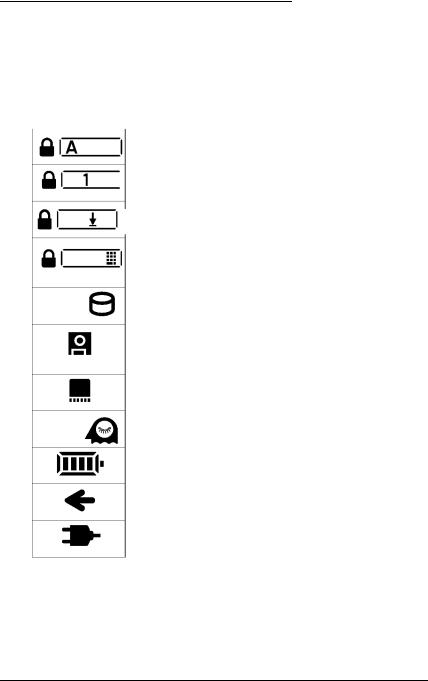
Reading the System Window lcons
These icons appear in the System Window above the keyboard to indicate the status of certain computer operations.
System Window icons
Icon |
Name |
Meaning |
|||
|
|
|
|
|
|
|
|
|
|
Caps Lock |
Caps Lock is on |
|
|
|
|
||
|
|
|
|
|
|
|
|
|
|
|
|
|
|
|
|
Num Lock |
Num Lock is on; also helps control |
|
|
|
|
||
|
|
|
|
|
embedded keypad; see Chapter 2 |
|
|
|
|
|
|
|
|
|
|
|
|
|
|
|
|
Scroll Lock |
Scroll Lock is on |
|
|
|
|
||
|
|
|
|
|
|
|
|
|
|
|
|
|
|
|
|
Embedded |
Embedded keypad is locked; see |
|
|
|
|
||
|
|
|
|
Keypad |
Chapter 2 |
|
|
|
|
Locked |
|
|
|
|
|
|
|
|
|
|
|
Hard Disk |
Computer is accessing the hard disk drive |
|
|
|
|
Activity |
|
|
|
|
|
|
|
|
|
|
|
Diskette |
Computer is accessing a diskette |
|
|
|
|
Drive |
|
|
|
|
|
Activity |
|
|
|
|
|
|
|
|
|
|
|
PC Card |
Computer is accessing a PC card |
|
|
|
|
Activity |
|
|
|
|
|
|
|
|
|
|
|
Suspend |
System is in suspend mode; see Chapter 3 |
|
|
|
|
|
|
|
|
|
|
Battery |
Gauges charging status and power left in |
|
|
|
|
Status |
the battery; see Chapter 3 |
|
|
|
|
|
|
|
|
|
|
|
|
|
|
|
|
Battery |
AC adapter is charging the battery; see |
|
|
|
|
Charging |
Chapter 3 |
|
|
|
|
|
|
|
|
|
|
AC Power |
AC adapter is connected to the |
|
|
|
|
|
computer; see Chapter 3 |
|
|
|
|
|
|
For more information about the AC Power, Battery Charging, Battery Status, and Suspend icons, see Chapter 3. For information on the Num Lock and Embedded Keypad Locked icons, see Chapter 2.
Setting Up the Computer 1-7

Making Backup Copies of Your Files
Before you start using your computer, it’s a good idea to make a backup copy of your hard disk drive. Use the MWBACKUP utility in the Windows Applications group or the MS-DOS BACKUP command to back up the contents of the drive. Refer to your on-line Windows manual or Windows Help utility for instructions on using MWBACKUP; use the MS-DOS help utility for instructions on using BACKUP.
You should make backup copies of any diskettes you have that contain programs and store the copies away from your originals. Also be sure to regularly backup your hard disk drive in case you need to restore the files and programs you keep there.
Running the System Configuration Utility
The System Configuration utility (SCU) defines your system’s configuration so the computer recognizes all of its devices. The SCU is stored in the computer’s ROM (read only memory), where you can access it whenever you turn on or reset the computer, or when you press Ctrl Alt S at the MS-DOS prompt.
Caution
The SCU reboots your computer when you exit the utility and any data left in your computer’s memory at that time is lost. If you want to run the SCU while you are using an MS-DOS application, save your data and exit the program before you press Ctrl Alt S. To protect you from losing any data, you cannot run the SCU from Windows.
The configuration you define through the SCU is stored in an area of memory called CMOS RAM, which is backed up by a battery and is not erased when you turn off or reset the computer.
1-8 Setting Up the Computer

Note
If you remove the computer’s battery and leave your system without a power source for more than 10 days, the internal battery runs out of power and does not retain your configuration information. If this happens, you must run the SCU again and re-enter any changes you made to the default settings.
When to Run the System Configuration Utility
Because your computer was set up and configured for you, the configuration information may already be correct for your needs. However, you may want to run the SCU to enter the correct time and date, set a password, or customize the power management features. (You can also access the power management features by pressing Ctrl Alt P or Fn Esc.) In addition, any time you change the computer’s configuration (by installing or removing memory, for example), you need to run the SCU to update the configuration.
Starting the Utility
You can start the SCU by pressing Ctrl Alt S at the MS-DOS prompt or during power-on diagnostics. To start the SCU during power-on diagnostics, make sure there is no diskette in the diskette drive; then turn on your computer. You see the following prompt at the bottom of your screen for 1 second:
< C T R L - A L T - S > t o e n t e r S y s t e m C o n f i g u r a t i o n Utility
As soon as you see this message, press Ctrl Alt S.
Setting Up the Computer 1-9
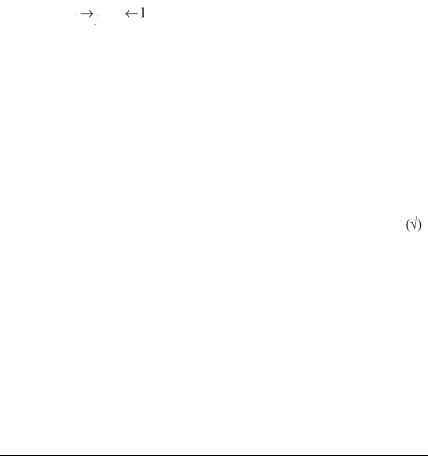
If you do not press Ctrl Alt S within 1 second, the computer loads Windows. If this happens, exit Windows and press Ctrl Alt S at the MS-DOS prompt to start the SCU.
Changing the Settings
When the computer starts the SCU, you see the System Configuration screen which lists the current configuration option settings. To select the options you want to change, use the pull-down menus that you open from the menu bar at the top of the screen. Some of the menu bar options access other screens, such as the Power Management option (PowerMgmt).
Use the and keys to highlight the menu bar option you want to select; then press Enter. If you prefer, you can also press the key for the highlighted letter in the menu option to select it. (The Defaults and Exit options do not have pull-down menus; see the table below for more information.)
Once you see a pull-down menu, use the or
or  keys to highlight the option you want to change and press Enter.
keys to highlight the option you want to change and press Enter.
You ’ll notice two ways to change a particular option’s setting:
 Select a setting or respond to a prompt displayed in a dialog box on the screen
Select a setting or respond to a prompt displayed in a dialog box on the screen
 Press Enter to enable or disable the option; a check mark indicates an enabled option.
Press Enter to enable or disable the option; a check mark indicates an enabled option.
To close a pull-down menu or dialog box, press ES C.
1-10 Setting Up the Computer

The SCU screen displays the detected size of your system
memory areas, |
including |
base, |
extended, and shadow memory. |
It also lets you |
change or |
verify |
the settings listed in the |
following table. An asterisk (*) next to an option indicates the default setting.
SCU options
Option |
Description |
|
Settings |
|
|
|
|
|
|
Standard menu |
|
|
|
|
|
|
|
||
Date |
Sets the date used by the |
mm/old/yyyy |
||
|
system |
|
|
|
|
|
|
||
Time |
Sets the time used by the |
hh:mm:ss |
||
|
system |
|
(24 hour format) |
|
|
|
|
|
|
Trackball |
Enables or disables the |
|
= Enabled* |
|
|
built-in trackball (assigned |
No |
= Disabled |
|
|
as COM1 ) |
|
|
|
|
|
|
||
COM Port |
Assigns the built-in serial |
COM2 (2F8h) * |
||
|
port address (the |
COM4 (2E8h) |
||
|
PCMCIA slots are COM3) |
Disable |
||
|
|
|
||
Parallel Mode (1) |
Assigns the operation |
Normal * |
||
|
mode of the parallel port |
Bidirectional |
||
|
|
|
Disable |
|
|
|
|
||
Diskette Drive |
Specifies a diskette drive |
1..44MB * |
||
|
type for drive A (drive B |
1.2 MB |
||
|
option is inoperable) |
None |
||
|
|
|
||
Hard Disk (2) |
Automatically detects the |
Custom |
||
|
drive type or allows you |
Auto * |
||
|
to define the parameters |
None |
||
|
|
|
|
|
Preferences menu |
|
|
|
|
|
|
|
|
|
Quick Boot |
Allows you to |
skip |
|
= Enabled |
|
non-essential |
diagnostic |
No |
= Disabled* |
|
tests at startup |
|
|
|
|
|
|
|
|
Num Lock |
Sets whether Num Lock |
|
= On |
|
|
mode is on or off when |
No |
= Off* |
|
|
you turn on or reset the |
|
|
|
|
computer |
|
|
|
|
|
|
|
|
Setting Up the Computer |
1-11 |

SCU options [continued)
Option |
|
Description |
Settings |
|
|
|
|
|
|
Typematic |
Rate |
Sets the speed at which |
2 CPS |
|
|
|
characters repeat when |
6 CPS |
|
|
|
you hold down a key; in |
10 CPS* |
|
|
|
characters per second |
15 CPS |
|
|
|
(Cps) |
20 CPS |
|
|
|
|
30 CPS |
|
|
|
|
|
|
Typematic |
Delay |
Sets the amount of time it |
250 ms |
|
|
|
takes before a key |
500 ms * |
|
|
|
repeats input when you |
750 ms |
|
|
|
hold it down; in |
1000 ms |
|
|
|
milliseconds (ins) |
|
|
|
|
|
|
|
Boot Password |
See "Setting, Deleting, |
|
= Enabled |
|
|
|
and Changing a |
No |
= Disabled * |
|
|
Password" below |
|
|
|
|
|
||
SCU Password |
See "Setting, Deleting, |
= Enabled |
||
|
|
and Changing a |
No |
= Disabled * |
|
|
Password" below |
|
|
|
|
|
|
|
Boot Drive |
|
Selects the drive the |
Drive A * |
|
|
|
computer should check |
Drive C |
|
|
|
first as it boots the system |
|
|
|
|
|
|
|
VGA menu |
|
|
|
|
|
|
|
|
|
Display Mode |
Selects the display mode |
LCD * |
|
|
|
|
the computer uses when |
CRT |
|
|
|
you boot the system |
BOTH (active matrix and |
|
|
|
|
monochrome only) |
|
|
|
|
|
|
LCD |
|
Sets the mode used to |
Normal * |
|
(appears |
|
display text and graphics |
Reverse |
|
only on |
|
against the background |
|
|
monochrome |
on your screen; |
|
|
|
models) |
|
normal = white on a |
|
|
|
|
black background, |
|
|
|
|
reverse = black on a |
|
|
|
|
white background |
|
|
|
|
|
|
|
1-12 Setting Up the Computer

SCU options [continued)
Option |
Description |
Settings |
|
Memory menu |
|
|
|
|
|
|
|
Cache Enable |
Controls the processor’s |
= |
Enabled* |
|
internal cache operation |
No |
= Disabled |
|
|
||
PowerMgmt |
See "Setting the Power Management Options," below |
||
menu |
|
|
|
|
|
||
Defaults |
Sets all options to their default values |
||
|
|
|
|
Exit |
See “Exiting the SCU, ” below |
|
|
|
|
|
|
*Default setting
(1)The parallel port is always LPT1. Some hardware diagnostic programs may only be able to read the parallel port in Normal mode.
(2)Select Auto so the computer can try to automatically configure your hard disk drive; select Custom to enter the specific parameters; select None if you removed your hard disk drive.
Setting, Deleting, and Changing a Password
You can set two types of passwords on your system: a Boot password and an SCU password. The Boot password prevents an unauthorized user from accessing any programs or data on your computer, including the System Configuration utility. The SCU password prevents access only to the SCU and your system configuration information.
If you set a Boot password, the computer prompts you to enter it each time you turn on or reset your computer. If you set an SCU password, the computer prompts you to enter it each time you press Ctrl Alt S to run the SCU.
Follow the instructions in the next sections to set, delete, or change your password. See the instructions in Chapter 2 for entering your password when the system prompts you for it.
Setting Up the Computer 1-13

Setting a password
Follow these |
steps |
to |
set a password: |
||
1. |
Highlight |
the |
Boot Password or SCU Password option. |
||
2. |
Press |
Enter. You |
see the password entry screen. (Press ESC to |
||
|
exit |
this |
screen, if |
necessary.) |
|
3.Type a password from 4 to 8 characters long. As you type,
you see only asterisks (*) displayed on the screen.
4.Press Enter. You see another password entry screen asking
you to verify the password by entering it again.
5.Type the password again and press Enter. (If you enter an incorrect password, you see an error message; start over again at step 1.)
6. You see |
a |
message verifying that a password is set. Press any |
key to continue. The selected password option setting is |
||
changed |
to |
(Enabled). |
Deleting or changing a password
If you want to delete or change a password, follow these steps:
1. Highlight the Boot Password or SCU Password option.
2. Press Enter; the  disappears and the password is disabled.
disappears and the password is disabled.
3.If you want to change the password, press Enter again. You see the password entry screen.
4.Type a new password from 4 to 8 characters long. You see
only asterisks (*) displayed on the screen.
5.Press Enter. You see another password entry screen asking you to verify the password by entering it again.
1-14 Setting Up the Computer

6.Type the password again and press Enter. (If you enter an incorrect password, you see an error message; start over again at step 1.)
7.You see a message verifying that a password is set. Press any
key to continue. The selected password option setting is changed to  (Enabled).
(Enabled).
Setting the Power Management Options
When you select the PowerMgmt option from the SCU menu bar, the screen changes to the Power Management screen. Use the menu bar and pull-down menu options the same way you use them on the SCU screen.
Note
You can also access this screen outside of the SCU by pressing Ctrl Alt P or Fn ESC at the MS-DOS prompt or by pressing Fn ESC from Windows. Then when you exit the Power Management screen, you return to the MS-DOS prompt or to Windows, depending on where you were when you brought up the screen.
Setting Up the Computer 1-15

The table below lists the power management options. For a complete description of how these options work, see Chapter 3.
Caution
If you use your ActionNote on a network, you should disable the computer’s power management features because they can interfere with your network software and prevent proper connection to the network.
Power management options
Option |
Description |
Settings |
Controls menu |
|
|
Power Savings |
Selects when the power |
|
management features are |
|
enabled; set Battery = enable |
|
when using battery power only |
Battery Low |
Selects whether to warn you of |
|
a low battery and enter |
|
suspend mode or to warn you |
|
and not enter suspend mode |
Alarm Resume |
Sets a time in which the system |
(1)automatically resumes activity after entering suspend mode; if enabled, select a time
System menu
Always *
Battery
Disable
4= Suspend *
No = Warn only
= |
Enable |
No |
= Disable * |
CPU Standby |
Sets an inactivity time period |
4 Sec * |
|
|
after which the system slows |
8 |
Sec |
|
down the CPU (in seconds) |
16 Sec |
|
|
|
Disable |
|
Global Standby |
Sets an inactivity time period |
1 Min |
|
|
after which the system turns off |
2 |
Min |
|
all devices and slows down the |
4 |
Min |
|
CPU (in minutes) |
6 Min* |
|
|
|
8 |
Min |
|
|
12 Min |
|
|
|
16 Min |
|
|
|
Disable |
|
|
|
|
|
1-16 Setting Up the Computer
